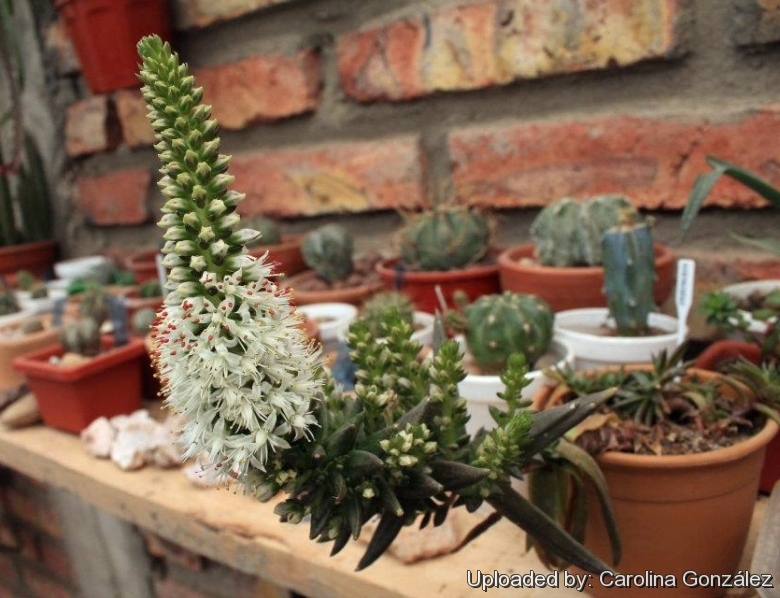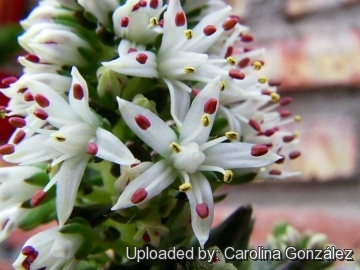Accepted Scientific Name: Orostachys japonica (Maxim.) A.Berger
Nat. Pflanzenfam., ed. 2 [Engler & Prantl] 18(a): 464 1930 Engl. & Prantl

Sedum malacophyllum var. japonicum (Orostachys japonica) Photo by: Carolina González
Origin and Habitat: Temperate Asia, China (Anhui, E Heilongjiang, Jiangsu, Shandong, Zhejiang ), Russia, Korea & Japan.
Habitat and ecology: Rocks on low mountains, along streams in China and surface of mountain rocks in Korea and Japan, both in sunny or semi-shaded (light woodland) location with a well-drained and moist soil that is low in nutrients. It is also grown on house roofs.
Synonyms:
See all synonyms of Orostachys japonica
back
Accepted name in llifle Database:Orostachys japonica (Maxim.) A.BergerNat. Pflanzenfam., ed. 2 [Engler & Prantl] 18(a): 464 1930Synonymy: 14
back
Common Names include:
ENGLISH: Rock pine
CHINESE (中文): Wan hong wa song (晚红瓦松)
JAPANESE (日本語): Tume-renge (ツメレンゲ - 爪蓮華 [meaning: nail lotus]), Hiroha-tume-renge (ヒロハツメレンゲ - 広葉爪蓮華 [meaning: broad leaved nail lotus])
KOREAN (한국어): 바위솔
PERSIAN (فارسی): ارستاچیس جاپنیکا
Description: Orostachys japonicaSN|30876]]SN|30876]] is a monocarpic biennial/perennial succulent herbs with leaves in dense rosettes which will elongate and flower in late summer and autumn. The flowers are white and are produced in the second or third year. When the flowers bloom and produce seeds, the rosette dries out. Because of its growing shape which resembles a pine tree's cone, and its habit of growing on mountain rocks, it is also called rock pine.
Taxonomy: The nomenclature of this species is controversial, we have followed V. V. Byalt who believes that the species identified as Orostachys erubescensSN|23463]]SN|23469]] is in fact O. japonica, whereas true Orostachys erubescensSN|23469]]SN|23469]] is a synonym of Orostachys spinosaSN|23469]]SN|23463]]. Two forms are recognised and occasionally seen in cultivation: the nominate and Orostachys japonicaSN|30876]]SN|30876]] f. polycephala (Makino) H.Ohba.
Rosettes: 2.5-6(-8) cm in diameter in summer.
Leaves: Fleshy, alternate, rosulate narrowly spatulate, 15-30 mm long, 4-7 mm wide in summer rosettes, grey-green to whitish-green, often bronzy-purple in winter. Apical spine not cartilaginous bristly, more conspicuous in winter rosettes.
Inflorescences: Dense spike-like, terminal racemes (6-)8-20(-30) cm long, 2-5 cm in diameter, from the center of the rosettes, stalked. Flowering-stem with stem leaves linear to linear-lanceolate, red dotted 20-60 mm long and 3-7 mm wide, narrowly acuminate and prickles absent. Bracts resembling stem leaves but smaller.
Flowers:* Hermaphrodite (have both male and female organs), pedicellate. Pedicels 2-7 mm long, with 2 to 5 secondary lanceolate bracts. Sepals 5, almost equal, oblong-ovate, about 2 mm long, 1 mm wide, tip obtuse. Petals 5, spreading, white, minutely punctate, lanceolate, about 6 mm long, 1.8 mm wide suberect, apex reddish and rounded. Stamens 10 shorter than the petals, anthers red at first, darkening to purple. Nectar scales subquadrangular, about 0.3 mm long, apex emarginate. Styles straight, slender ca. 2 mm, carpels 5, erect, lanceolate, ca. 6 mm, abruptly tapered toward base, ovaries stalked.
Blooming season: Summer—autumn (in habitat September to November).
Fruits: Erect, free.
Seeds: Brown, ca. 1 mm.
Chromosome number: 2n = 24 - 48.
Bibliography: Major references and further lectures
1) Wikipedia contributors. "Orostachys japonica." Wikipedia, The Free Encyclopedia. Wikipedia, The Free Encyclopedia, 8 Dec. 2014. Web. 27 Mar. 2015.
2) James Cullen, Sabina G. Knees, H. Suzanne Cubey “The European Garden Flora Flowering Plants: A Manual for the Identification of Plants Cultivated in Europe, Both Out-of-Doors and Under Glass” Cambridge University Press, 11 August 2011
3) Hayashi, Azegarni & Hishiyama, “Wild flowers of Japan,” 439 (1983)
4) Graf, “Tropica” 374 (1978)
5) Ohba, H., “Notes towards a monograph of the genus Orostachys (Crassulaceae)” (1), Journal of Japanese Botany 65(7): 193-203 (1990).
6) Orostachys japonica A. Berger in Engler & Prantl, Nat. Pflanzenfam., ed. 2. 18a: 464. 1930
7) “Orostachys japonica” in Flora of China on-line. FOC Vol.8 241000249. [http://www.efloras.org/florataxon.aspx?flora_id=2&taxon_id=241000249] Flora of China on-line. Web. 27 Mar. 2015.
8) "Medicinal Plants In the Republic of Korea." Natural Products research institute (Seoul National University). p. 187.
 Sedum malacophyllum var. japonicum (Orostachys japonica) Photo by: Carolina González
Sedum malacophyllum var. japonicum (Orostachys japonica) Photo by: Carolina GonzálezSend a photo of this plant.The gallery now contains thousands of pictures, however it is possible to do even more. We are, of course, seeking photos of species not yet shown in the gallery but not only that, we are also looking for better pictures than those already present.
Read More... Cultivation and Propagation: Orostachys japonicaSN|30876]]SN|30876]] is an interesting plant and easy to grow in container or in the rock garden. It grows well in any position where the common Houseleek (Sempervivum tectorumSN|19333]]SN|19333]]) may be grown, and in any soil. It can also be cultivated on the roofs of buildings.
Soil: It does not seem fussy about conditions in the garden. Require a very freely drained soil. Outdoors it will spread itself through narrow locations between rockery stones. It does not prefer rich loamy soil; gritty dirt with pea gravel suits it.
Watering: It takes little water & could rot if watered too often. During the growing season, the plants are watered and allowed to dry slightly before watering again. Although they can take a great deal of drought, they seem to do better with regular (but moderated) watering. During the winter months, plants are watered very little.
Exposition: It need full sun to light shade and tolerates shade, but a sunny spot is nicest, though in warmer climates it needs protection from too much sun because it is not very heat tolerant.
Frost Tolerance: Hardy at least to -12°C (or less).
Remarks: After the plant blooms and sets seed it will die, but there will be many offsets to take its place.
Uses: It is choicest species for the rock-garden and borders, it can be used for edgings, lines and panels in the flower garden, and naturalized on walls, ruins, or any position where the Common Houseleek thrives.
Medicinal uses: The leaves and stems contain several medically active constituents including fatty acid esters, Friedelin and flavonoids. They are antispasmodic and cytotoxic. It strengthens the immune system of our body to produces specialized antibodies, preventing some disease. It has anti-cancer effect, suppressing the propagation of cancer cells. For this reason, it uses in the treatment of tumor and other disease. In Korea, they are used in the treatment of cancer, gingivitis, coagulation and metritis.
Propagation: It is usually propagated from seed or offsets.











